Marine Plankton
|
Planktonic organisms are unable to swim against a current. Being planktonic is a lifestyle and includes members from a wide variety of classifications (plants and animals, small and large). It includes the drifters who cannot swim at all as well as those that can swim feebly. There is no definition as to the exact speed at which an organism must swim so that it is no longer considered plankton. Planktonic organisms are part of the pelagic division (see lesson 1.2.3), or water dwellers (as opposed to the benthic division, or bottom dwellers). Pelagic organisms are grouped as plankton or nekton. Nektonic critters are capable of swimming against a current and include most species of sharks, rays, fish, seals, sea lions, and whales. But, without a clear definition of the speed of swimming there is a large 'gray' area where between planktonic and nektonic organisms. It really does not matter though as these words just help us in describing the life forms in the water.
|
|
Plankters are divided into the phytoplankton and zooplankton by their trophic level. The phytoplankters are the producers (photosynthesizing to get their cell food for cellular respiration). The zooplankters are the consumers (eating, at various trophic levels, to get their cell food for cellular respiration). Most phytoplankters are very small and usually microscopic.
|
|
Plankters are also divided into the holoplankton and the meroplankton by their life cycle modes. The holoplankton spend their entire life in the plankton. The meroplankton spend only part of life in plankton. It is said that somewhere around 80 percent of the bottom dwelling animals spend their young (larval) life in the plankton and may be quite small (microscopic). On the other hand, some animal plankters are quite large (many feet in length) and are considered plankton because they are very feeble swimmers.
|
|
Phytoplankton is the most common marine producer at the bottom of the marine food pyramid. Although seaweeds are also marine producers they are limited to coastal areas where the bottom (for attachment) is within the photic zone but phytoplankton can be found near the surface of the ocean all over the world (over 70 percent of the surface of Earth).Phytoplankton are the source of most of the primary production in the world's oceans. Primary production is the rate that carbon dioxide is converted to sugars through photosynthesis. It is an important measure of the energy available in the trophic system. When there are large numbers of phytoplankton with the nutrients they need for photosynthesis, the primary production rate will be high. This will support large populations of consumers, such as zooplankton. High rates of photosynthesis also means carbon dioxide is being pulled from the water and oxygen is being released.
|
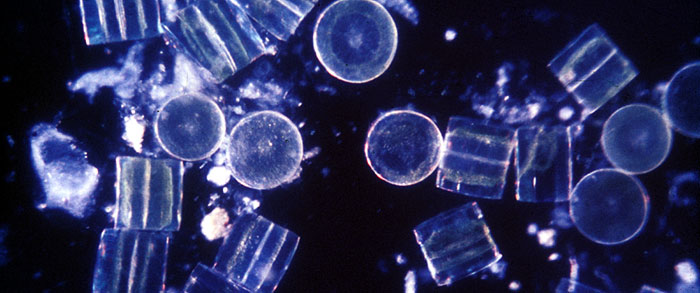
|
A group of diatoms (above) showing the round top and bottom view as well as the rectangular or square side view.
|
Diatoms can exist as solitary individuals (above left is a side view of one) or as colonies, often in chains (above right).
|
|
Diatoms are the most common phytoplankter. They are one celled producers with a covering (called a frustule) of glass. This frustule is made of two parts, much like a hat box (or petri plate). The largest part (like the lid) is called the epitheca and the smaller part is called the hypotheca. From top and bottom view they are round but from a side view they are square or rectangular and you can sometimes see the overlap of the epitheca and hypotheca. The top and bottom are loaded with tiny pores that make the frustule a lot lighter in weight and also provide a place for materials to move in and out of the cell. Many species have flotation mechanisms (spines, internal oil droplets, colonies). Diatoms are important oxygen producers in marine ecosystems (usually the first step in the food chain). They are holoplanktonic. When conditions are bad they die, sink, the cell decomposes and the frustule breaks up and mixes with sand and mud. This combination of sediments and glass frustules makes a siliceous ooze called diatomaceous earth (see lesson 2.3.2). It is mined by man for its filtering properties and the frustule pieces used as grit.
|
Asexual reproduction occurs with diatoms in good conditions in a unique way so that some get smaller and smaller until they are too small to function properly. This occurs when each frustule makes a new part - the original epitheca makes a new hypotheca inside the reproducing diatom resulting in a diatom the same size as the original diatom. The original hypotheca makes a new piece of frustule that will become a hypotheca inside the reproducing diatom - the original hypotheca now becomes an epitheca resulting in a diatom smaller than the original diatom. If this goes on for many divisions (as happens when conditions are very good and splitting can occur every few hours) there are a wide variety of diatom sizes concentrated in the water - some large and many small. The very tiny ones can no longer carry on cellular activities - these are the ones that become sexual. They form eggs or sperm (depending on their sex that was not obvious before). The sperm is released and when it fertilizes an egg the resulting zygote drops the tiny frustule, swells up to a large size and secrets a new large frustule.
Certain species of diatoms produce harmful chemicals (most notably domoic acid) which can concentrate in animals who eat plankton (filter feeders). Large amounts of domoic acid consumed by mammals (such as seals, sea lions and humans) can cause erratic behavior and lead to death. (See the paragraph below on the seasonality of the plankton for details.)
|
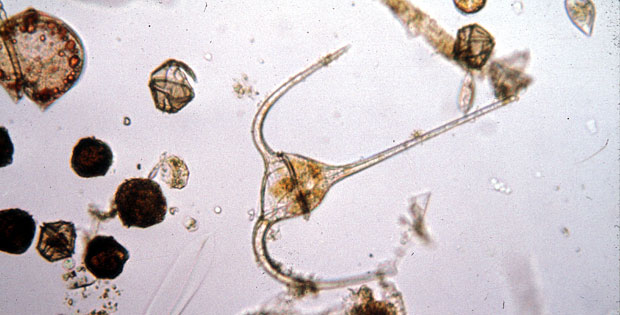
|
A Ceratium dinoflagellate (above).
|
|
Dinoflagellates are producers and consumers. They are seasonally abundant and are one of the primary causes of red tides, seawater bioluminescence, and shellfish poisoning. Dinoflagellates are one celled critters and because they could both photosynthesize and ingest organic material it was hard to classify them as either a plant or animal for many years. Now they are in the Kingdom Protoctista which also includes the unicellular diatoms, protozoa and the multicellular seaweeds - all with unicellular reproductive structures. This kingdom is quite diverse! The typical dinoflagellate cell is covered with tiny plates that fit together like a jigsaw puzzle creating a pointy top and a double pointy bottom with a groove around the middle and extending between the double points on one side. The single point is called the epicone and is generally the part of the animal that is moving forward. The double pointed side is called the hypocone. There are two flagellae - one in the groove around the middle (called the cingulum) and the other one in the groove between the two points of the hypocone (called the sulcus) and trailing into the water. The motion of the flagellum in the cingulum causes the dinoflagellate to spin and the motion of the flagellum in the sulcus causes it to move through the water with its epicone in front. Dinoflagellates are considered to be holoplanktonic, many with flotation mechanisms similar to the diatoms (spines, oil droplets, colonies).
|
|
Asexual reproduction also occurs with dinoflagellates in good conditions. In this case the dinoflagellate splits in half (at the cingulum) and reforms the missing part. Each of the resulting two cells are the same size as the original dinoflagellate cell so there is no size reduction as there is with diatoms. Dinoflagellates can reproduce at alarming rates (like diatoms) when conditions are good for them (correct light, temperature, nutrients) and these explosions are called 'blooms.' In poor conditions dinoflagellates can form several types of cysts to weather out the bad conditions and begin functioning again when conditions improve. Sexual reproduction does occur with dinoflagellates but its mechanisms are not well known.
|
|
Blooms of dinoflagellates cause red tide, shellfish poisoning, and bioluminescence if the bloom is concentrated enough. Different species are responsible for these phenomena and some species are responsible for several of these. It works like this ... generally there are a few of each of the species that can produce these effects living in the seawater but when there is a bloom they can become so exceptionally concentrated that these effects are noticed. Examples are given below:
|
A red tide dinoflagellate (above) stands out from the rest with its red oil droplets inside its cell.
|
Red tide occurs when the ocean water takes on a red/brown cast (but is not due to sediments washed into the ocean from the land) due to a dinoflagellate bloom. Certain dinoflagellate species have a red/brown oil droplet within their cell. When there are only a few they are not noticed in the water as to overall water color but when they bloom and are very concentrated they make the water appear red/brown. These red tides may be small patches or extend over many miles. During and after a red tide these dinoflagellates die and bacteria decompose their dead cells. The bacteria use up a lot of dissolved oxygen in the seawater so that areas of red tide may have little, or no, oxygen. If oxygen levels are low this can affect organisms in the water, such as fish. If the marine organism needs dissolved oxygen and cannot leave the red tide then it may suffocate and die. Fish kills due to red tide are common when the red tide extends for many miles. Some people think the dinoflagellate killed the fish but this is not true - the fish suffocated from lack of oxygen caused by the decomposing dinoflagellates due to bacteria. Whew ... a bit complicated but very interesting.
Shellfish poisoning occurs when poisonous species are concentrated and consumed by man. Shellfish poisoning (sometimes call PSP, or paralytic shellfish poisoning) occurs in areas where certain species of dinoflagellates bloom, are concentrated by filter feeding shellfish, and then consumed by man. Many of these species are associated with red tide, but not all of them. The toxins in these species are not enough to hurt a swimmer in the ocean who may swallow a little seawater during such a bloom but filter feeders concentrate the toxin in gallons and gallons of water each day. These filter feeders (like mussels) are not poisoned themselves but carry the toxin so that if they are eaten by humans (who are poisoned by these toxins) the humans may develop paralysis which could lead to death. Blooms of these toxic dinoflagellates generally occur only during the months between May 1 and the end of October in California. A 'Mussel Quarantine' is posted each year along California seashores to keep people from harvesting filter feeding shellfish between May 1 and October 31. The California State Department of Health samples plankton all along the coast on a monthly basis to track the plankton blooms.
|
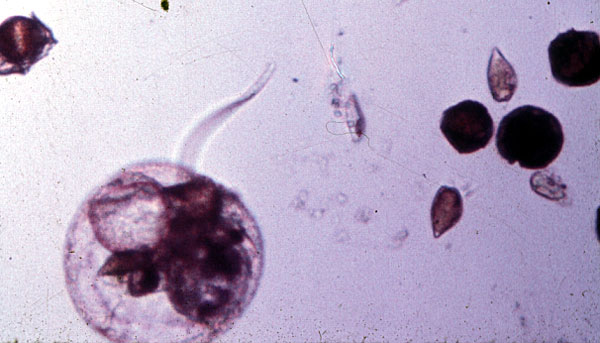
|
A bioluminescent dinoflagellate (above, left) has a very different shape than other dinoflagellates.
|
Bioluminescence of seawater is a spectacular sight due to some dinoflagellates. Some species of dinoflagellates will produce a blue/green light, after dark, when they are disturbed. This probably functions to scare predators away in the natural environment. There are always a few of these dinoflagellates in the water but their small size keeps their tiny spark of light from being visible on most nights. But, if these species are blooming, and very concentrated in the seawater, every movement of the water produces a glow - waves appear to light up as they break at night and fish leave glowing trails in the water as they swim at night. This phenomenon is seen all over the world but is usually seasonal so you are a lucky person to be in an area where it is happening. It is a unique experience to swim in the ocean at night when there is bioluminescence.
Not all species of dinoflagellates are responsible for red tide, shellfish poisoning and bioluminescence. When one of these phenomena are occuring the others may (or may not) also be occurring. And, there may be a large dinoflagellate bloom of a species that is not responsible for any of these at all. These blooms are usually seasonal but to predict the exact time and if the bloom will be large enough to exhibit these phenomena is too difficult.
Besides diatoms and dinoflagellates there are a few meroplanktonic phytoplankters but these are rather uncommon. Meroplanktonic phytoplankters would include the sexual products of the seaweeds like eggs, sperm, pollen, zygotes, and spores.
|
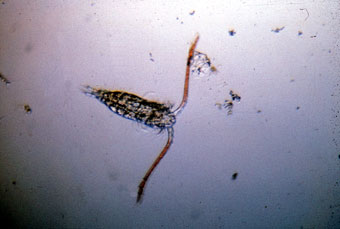
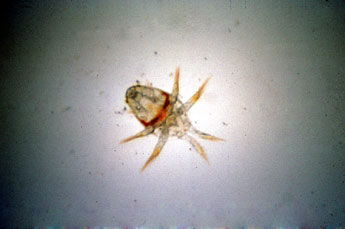
|
Copepods (above left) are one of the most common zooplankters. They feed on diatoms and are often found in great numbers when diatoms are blooming. Baby copepods (above right) lack the long antennae and tail but grow it very soon.
|
|
The zooplankton is usually the second step in phytoplankton based food pyramids. Many zooplankters are herbivores on the phytoplankton (diatoms and dinoflagellates). Almost every marine animal phylum has a larval stage that can be found in the plankton (sponges, sea anemones, worms, snails, crabs, lobsters, sea stars). These larval forms look very different from the adults and are usually considered to be meroplanktonic because the adults are either benthic or nektonic. Holoplanktonic forms of zooplankton are also found, primarily small crustaceans (like copepods and krill). These are almost totally dependent on diatoms for food so their population levels rise and fall with the diatoms blooms.
|
Seasonality of the plankton in California is generally a spring and a fall bloom with low levels of plankton in winter and summer. This is similar to many temperate areas. Polar areas have a single summer bloom and tropical areas generally lack any substantial blooms. Polar and tropical productivity and plankton blooms will be discussed in the Antarctica (4.3) and Arctic lessons (4.4), for polar blooms, and the Coral Reef lesson (4.1), for tropical blooms. A season by season description of temperate conditions can explain why there are two temperate blooms.
During winter there are low light levels and high nutrient levels so that phytoplankton is light limited (low phyto levels) and zooplankton is food limited (low zoo levels).
During spring there are high light levels and high nutrient levels so that the phytoplankton begins blooming at tremendous rates (high phyto levels) and the zooplankton follows (high zoo levels). This is usually the largest of the two temperate plankton blooms.
During summer there are high light levels but low nutrient levels so that the phytoplankton is nutrient limited (low phyto levels) and the zooplankton is food limited (low zoo levels). The low nutrient levels are because there is a summer thermocline which separates warm surface water from cool deeper water - nutrients are released by decomposers which are concentrated in the deeper water where dead organisms end up after they die and sink. The separation of the nutrient-rich lower water from the sunlit upper waters keeps phytoplankton from blooming. In temperate waters the thermocline is usually only found in the summer (whereas it is all year long in the tropics) and it breaks up in the fall, mixing the nutrient rich bottom water with the surface water.
During fall there are relatively high light levels (but the light is declining) and high nutrient levels (due to the breakup of the summer thermocline. This produces conditions for another bloom (high phyto followed by high zoo) but it is short lived as fall light levels decrease to winter. This fall bloom is rarely as large as the spring bloom but important none the less.
In California the spring and fall blooms (and any other small minor blooms) generally occur between May 1 and October 31. This is the time to expect any red tide, shellfish poisoning and seawater bioluminescence in California if it is going to happen that year. It is also the time the State of California makes all filter-feeding shellfish off limits to collection because of the health risks. Shellfish that are not filter-feeders (like abalone) are not affected by plankton blooms directly.
The coastlines of Oregon and Washington tend to experience a summer phytoplankton bloom. Upwelling, due to winds from the north, brings nutrients and cool water to the surface from June to August. Shellfish harvest is typically closed mid-summer due to harmful algal blooms along the Pacific Northwest coastline.
|
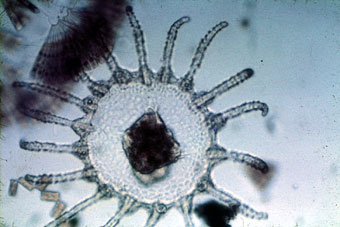
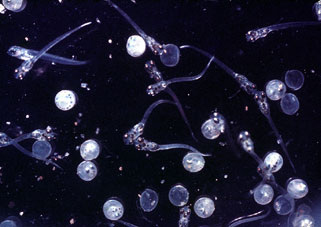
|
Planktonic medusae (like the one above left) and planktonic baby fish (above right) are often seen in plankton tows.
|
Baby crabs (above left) and barnacles (above right) have larval stages (shown above) that do not look much like the adult stage.
|
|
Plankton is a unique ecological component of aquatic ecosystems. Finding the medium of the ecosystem (seawater in the marine environment) full of life forms (plankton) is not a condition we find on land. The air (our terrestrial medium) has little in it that could be considered food for consumers. But, in the ocean the areas with plankton are like a nutritious soup and many species of marine animals are 'filter-feeders,' taking advantage of this plankton for their food. This filter-feeding mode is not found in terrestrial communities but is very common in the ocean. As you think about this ecological difference also think about some of the species in the plankton that are part of the reproduction of marine life forms - eggs, sperm, zygotes, larval forms. This is also a different reproductive tactic in aquatic ecosystems - that is organisms can broadcast spawn (by releasing their eggs and sperm into the water) without mating and/or have their larval form planktonic. Nothing like this occurs on land - imagine a land organism throwing out its eggs or sperm into the air in hopes it would mix and produce a zygote (like aquatic broadcast spawners do in the oceans). Also imagine a land organism throwing its babies into the air in hopes the baby would find enough to eat on its own and a good place to land and survive. The plankton is an interesting ecological aspect of aquatic environments and one that makes them quite different than terrestrial environments. Along with the interconnectedness of the oceans the marine environment has many opportunities for life forms to disperse.
|
|

(Revised 23 September 2018, R Martin) |    |
|

